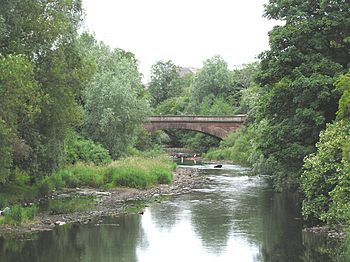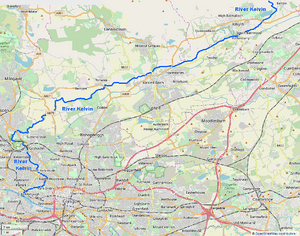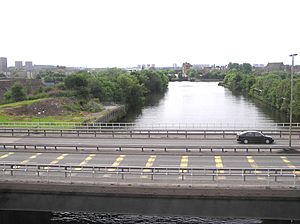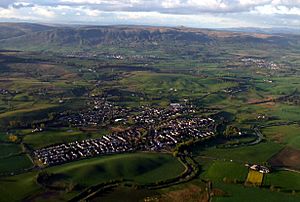River Kelvin facts for kids
Quick facts for kids River Kelvin |
|
|---|---|

The Kelvin flowing through Kelvingrove Park
|
|
 |
|
| Country | Scotland |
| Physical characteristics | |
| Main source | close to Banton, Scotland |
| River mouth | River Clyde Glasgow, Scotland |
| Length | 35 km (22 mi) |

The River Kelvin (in Scottish Gaelic: Abhainn Cheilbhinn) is a river in Scotland. It flows through the northern and northeastern parts of Glasgow. The Kelvin is a branch, also called a tributary, of the larger River Clyde.
The river starts on a moor near the village of Banton. It is about 35 kilometers (22 miles) long. At first, it flows south to a place called Dullatur Bog. There, it turns west into a man-made channel. It then flows alongside the Forth and Clyde Canal.
A famous scientist, William Thomson, was given the title Baron Kelvin. This honor was named after the River Kelvin, which flowed past his university.
Contents
What's in a Name?
The name Kelvin likely comes from an old language called Common Brittonic. It might be related to a word that means "stem" or "stalk."
Where the River Flows
The River Kelvin has many smaller streams that join it. These are called tributaries.
- One of the first important streams to join is the Chantyclear Burn.
- Further west, the Shawend Burn adds its water.
- The Garrel stream joins south of Dumbreck Marsh.
- As the Kelvin flows through a wide, flat area near Twechar, it is joined by several other streams. These include the Dock Water, Queenzie Burn, Cast Burn, and Board Burn.
- Near Kirkintilloch, the larger Glazert and Luggie rivers flow into the Kelvin.
- The river then winds past Torrance and through Balmore Haughs.
- South of Bardowie, the Allander Water joins the Kelvin.
- Finally, the River Kelvin flows southwest through areas like Maryhill, Hillhead, and Kelvingrove Park. It then empties into the River Clyde in Glasgow.
Animals in and Around the River

The area around the River Kelvin is home to many different animals. You might see:
- Mammals like grey squirrels, roe deer, foxes, otters, water voles, mink, and brown rats.
- Birds such as magpies, grey herons, cormorants, blue tits, great tits, chaffinches, snipes, great spotted woodpeckers, blackbirds, redwings, carrion crows, kingfishers, mallards, and goosanders.
Efforts to make the river water cleaner have been very successful. Because of this, salmon have returned to the river! The Kelvin has always had brown trout. If you have the right permits, you can fish for both salmon and trout here.
Bridges Over the Kelvin
Many bridges cross the River Kelvin as it flows through Glasgow.
- One well-known bridge is the Great Western Bridge on Great Western Road.
- Below this bridge, there is an underground train station called Kelvinbridge. This name is also used for the area around the station.
- Other bridges include one near the ancient Antonine Wall at Balmuildy, Partick Bridge on Dumbarton Road, and the bridge at Queen Margaret Drive.
- There's also the Ha'penny Bridge and several bridges within Kelvingrove Park.
The Kelvin Aqueduct is a special bridge that carries the Forth and Clyde Canal over the river. When it was built, it was the largest aqueduct in Britain. The river also acts as an overflow for the canal, helping to manage its water levels.
See also
In Spanish: Río Kelvin para niños

